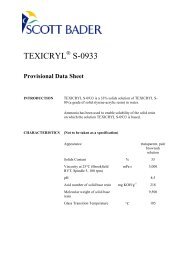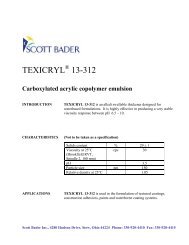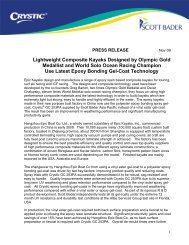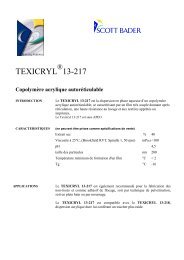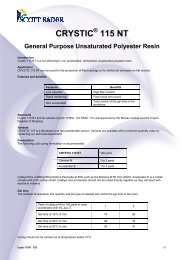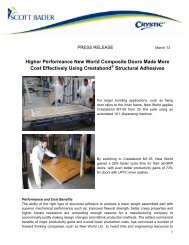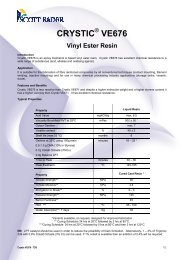CRYSTIC 489 and CRYSTIC 489PA - Scott Bader
CRYSTIC 489 and CRYSTIC 489PA - Scott Bader
CRYSTIC 489 and CRYSTIC 489PA - Scott Bader
- No tags were found...
You also want an ePaper? Increase the reach of your titles
YUMPU automatically turns print PDFs into web optimized ePapers that Google loves.
<strong>CRYSTIC</strong> ® <strong>489</strong><strong>and</strong> <strong>CRYSTIC</strong> ® <strong>489</strong>PAIntroductionCrystics <strong>489</strong> <strong>and</strong> <strong>489</strong>PA are thixotropic, isophthalic polyester resins. When used with Crystic Gelcoat 65PA, theyproduce a matched performance system for moulding boat hulls with outst<strong>and</strong>ing durability <strong>and</strong> superior blisterresistance.The outst<strong>and</strong>ing wetting characteristics of Crystics <strong>489</strong> <strong>and</strong> <strong>489</strong>PA give rapid impregnation with freedom from drainage.They are suitable for use with continuous rovings, carbon fibres <strong>and</strong> aramid fibres. Fully cured laminates made withCrystics <strong>489</strong> <strong>and</strong> <strong>489</strong>PA have high mechanical <strong>and</strong> impact properties <strong>and</strong> excellent strength retention in wetenvironments at temperatures up to 40ºC. The interlaminar adhesion properties of the resins ensure that no loss instrength occurs at the interface between layers, following any delay in lay-up. Crystics <strong>489</strong> <strong>and</strong> <strong>489</strong>PA are tinted blue, tofacilitate easier identification <strong>and</strong> removal of any air trapped in laminates.ApprovalsCrystics <strong>489</strong> <strong>and</strong> <strong>489</strong>PA are approved by Lloyd’s Register of Shipping for use in the construction of craft under theirsurvey, <strong>and</strong> by Det Norske Veritas. They also meet the requirements of B.S.3532:1990, Type B.FormulationCrystics <strong>489</strong> <strong>and</strong> <strong>489</strong>PA should be allowed to attain workshop temperature (18ºC-20ºC) before use. Crystic <strong>489</strong>PAneeds only the addition of a catalyst to start the curing reaction. The recommended catalyst is Catalyst M (or ButanoxM50). The catalyst should be added at 1% or 2% into the resin <strong>and</strong> thoroughly dispersed, shortly before use.Crystic <strong>489</strong> requires the addition of a catalyst <strong>and</strong> an accelerator to start the curing reaction.N.B. Catalyst <strong>and</strong> accelerator must not be mixed directly together since they can react with explosive violence.The recommended catalyst is Catalyst M (or Butanox M50), which should be added at 2% into the resin, <strong>and</strong> thoroughlydispersed. Shortly before use, 4% of Accelerator E should be stirred into the catalysed resin.The geltimes of Crystics <strong>489</strong> <strong>and</strong> <strong>489</strong>PA can be approximately determined from Tables I <strong>and</strong> II:-Pot LifeTable I - Crystic <strong>489</strong>Parts of Accelerator E to100 Parts Catalysed Resin 4.0Pot life in minutes at 15ºC 21Pot life in minutes at 20ºC 14Pot life in minutes at 25ºC 8Table II - Crystic <strong>489</strong>PAParts of Catalyst M to100 Parts Resin 1.0 2.0Pot life in minutes at 15ºC 60 24Pot life in minutes at 20ºC 40 18Pot life in minutes at 25ºC 23 12The resins, mould <strong>and</strong> workshop should all be at, or above, 15ºC before curing is carried out.AdditivesSince the addition of certain pigments, fillers or extra styrene may adversely affect the properties of Crystics <strong>489</strong> <strong>and</strong><strong>489</strong>PA, users are urged to seek the advice of our Technical Service Department before making any such additions.Crystic <strong>489</strong> <strong>and</strong> Crystic <strong>489</strong>PA - TDS 1/3
Post CuringSatisfactory laminates for many applications can be made from Crystics <strong>489</strong> <strong>and</strong> <strong>489</strong>PA by curing at workshoptemperature (20ºC). For optimum properties <strong>and</strong> long term performance, however, laminates should be post curedbefore being put into service. The laminate should be allowed to cure for 24 hours at 20ºC <strong>and</strong> then be oven cured for 3hours at 80ºC or 16 hours at 40ºC.Typical PropertiesThe following tables give typical properties of Crystics <strong>489</strong> <strong>and</strong> <strong>489</strong>PA when tested in accordance withBS 2782.Liquid ResinProperty <strong>489</strong> <strong>489</strong>PAAppearance Blue BlueViscosity at 25ºC 37.35 sec -1 poise 7.3 4.4Viscosity at 25ºC 4500 sec -1 poise 3.3 2.5Specific Gravity at 25ºC 1.10 1.11Volatile Content % 42 43Acid Value mg KOH/g 19 18Stability in the dark at 20ºC months 6 3Geltime at 25ºC using 1% Catalyst M(or Butanox M50)Geltime at 25ºC using 2% Catalyst M <strong>and</strong>4% Accelerator Eminutes - 23minutes 8 -Fully Cured* Resin(unfilled casting)Property <strong>489</strong> <strong>489</strong>PABarcol Hardness (Model GYZJ 934-1) 46 44Deflection Temperature under load †(1.80 MPa)ºC 80 77Water Absorption 24 hours at 23ºC mg 18 17Tensile Strength MPa 80 76Tensile Modulus MPa 3600 3500Elongation at Break % 4.3 4.0Specific Gravity at 25ºC 1.21 1.20Volumetric Shrinkage % 7.7 7.7Property* Curing Schedule - 24 hrs at 20ºC, 3 hrs at 80ºC† Curing Schedule - 24 hrs at 20ºC, 5 hrs at 80ºC, 3 hrs at 120ºCC.S.M** Laminate<strong>489</strong> <strong>489</strong>PAGlass Content % 32.0 31.8Tensile Strength MPa 130 128Tensile Modulus MPa 7800 7700Elongation at Break % 2.0 2.1Flexural Strength MPa 214 212Flexural Modulus MPa 7500 7400** Made with 4 layers 450g/m 2 PB CSMCuring schedule - 24hrs at 20ºC, 16hrs at 40ºCCrystic <strong>489</strong> <strong>and</strong> Crystic <strong>489</strong>PA - TDS 2/3
StorageCrystics <strong>489</strong> <strong>and</strong> <strong>489</strong>PA should be stored in the dark in suitable closed containers. It is recommended that the storagetemperature should be less than 20ºC where practical, but should not exceed 30ºC. Ideally, containers should be openedonly immediately prior to use.PackagingCrystics <strong>489</strong> <strong>and</strong> <strong>489</strong>PA are supplied in 25kg <strong>and</strong> 200kg containers. Bulk supplies can be delivered by road tanker.Health & SafetyPlease see separate Material Safety Data Sheet.Technical Leaflet No. 172.5Version 2 : February 2013All information on this data sheet is based on laboratory testing <strong>and</strong> is not intended for design purposes. <strong>Scott</strong> <strong>Bader</strong> makes no representations or warranties of anykind concerning this data. Due to variance of storage, h<strong>and</strong>ling <strong>and</strong> application of these materials, <strong>Scott</strong> <strong>Bader</strong> cannot accept liability for results obtained. Themanufacture of materials is the subject of granted patents <strong>and</strong> patent applications; freedom to operate patented processes is not implied by this publication.SCOTT BADER COMPANY LIMITEDWollaston, Wellingborough, Northamptonshire, NN29 7RLTelephone: +44 (0) 1933 663100Facsimile: +44 (0) 1933 666623www.scottbader.comCrystic <strong>489</strong> <strong>and</strong> Crystic <strong>489</strong>PA - TDS 3/3





